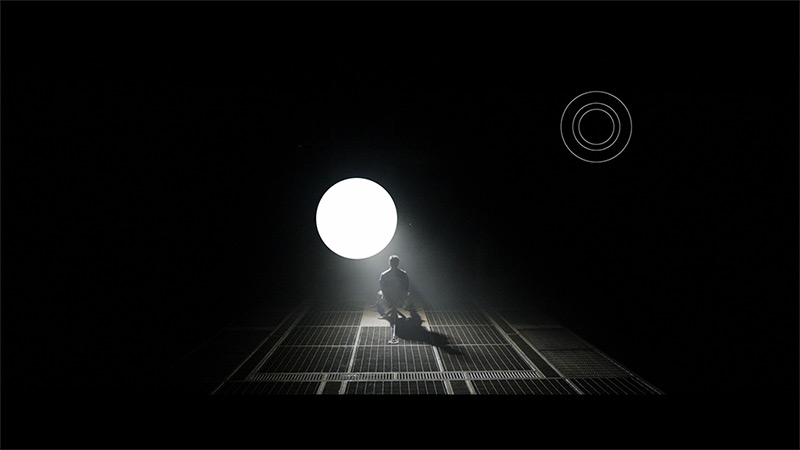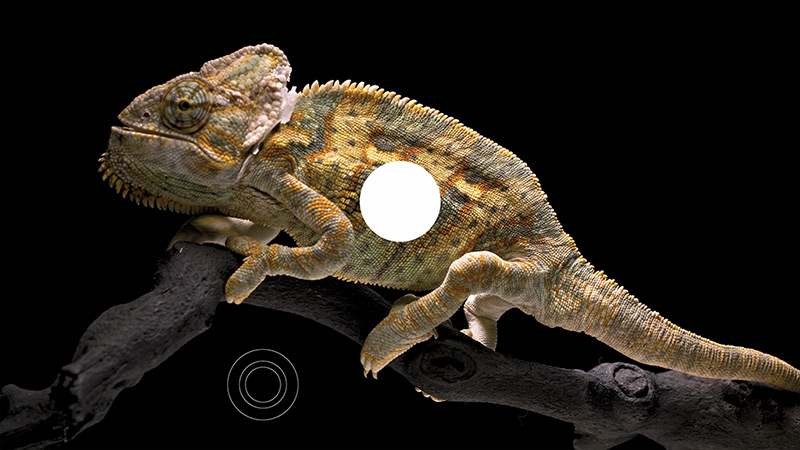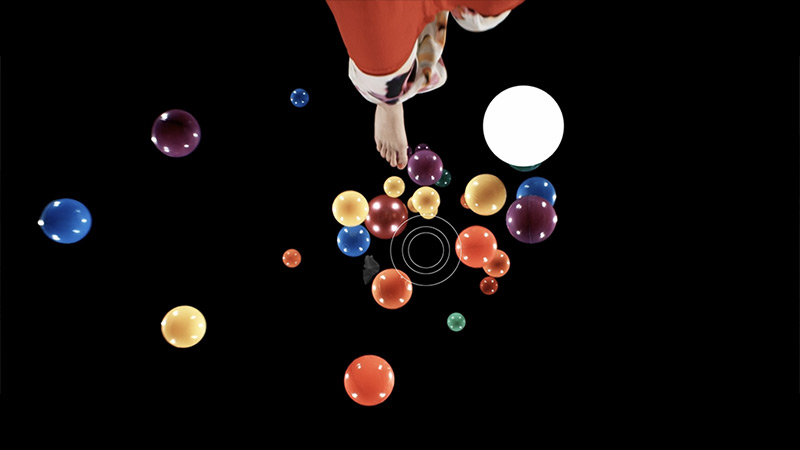The Samsung QN95D immediately made a great impression on us. Right from the start, we felt that the Tizen system is intuitive and quick. The fast access to streaming applications such as PrimeVideo, Netflix, and MAX, as well as the ability to integrate with the SmartThings ecosystem, makes using the television simply convenient. The solar remote is a clever solution – eco-friendly and practical, as it allows control of other devices, such as a decoder (e.g. Canal+) or soundbar. While watching films and series, we quickly noticed how much of a difference the MiniLED technology makes. Thanks to the precisely functioning backlight zones, the picture gained incredible depth - which was confirmed by our contrast tests. The blacks are truly deep, and bright scenes using HDR stand out with excellent detail despite the lack of Dolby Vision. Additionally, the high brightness combined with the anti-reflective coating allows for comfortable viewing even in a sunlit room. When we played on this television, we immediately appreciated the low input lag and the fluidity of the image. The 144 Hz panel and support for HDMI 2.1 guaranteed dynamic and responsive gameplay, regardless of the game. All these features made every gaming session pure pleasure, especially in dynamic titles where precision and lack of delays matter. In terms of design - which is worth mentioning for this television - the QN95D simply looks great. The slim housing, solid central stand, and Ambient Mode function, which allows the screen to blend into the room's decor, give it an elegant touch. The included camera is an interesting addition that can be useful during video calls or when using interactive applications – like personal training through the Daily+ tab. However, for such, let’s be honest, an expensive piece of equipment, there are a few downsides. The lack of a recording function and support for sound in DTS:X format may be a problem for users seeking this feature. Nevertheless, the Samsung QN95D is a television that combines exceptional picture quality, functionality, and elegant design. The MiniLED backlighting makes a real difference here, especially if we care about deep blacks, high contrast, and excellent brightness. This is a device that will perform well during movie screenings, dynamic gaming, and everyday television watching.
- Matching (Score)
- Our verdict
- TV appearance
- Where to buy
- Contrast and black detail
- HDR effect quality
- Factory color reproduction
- Color reproduction after calibration
- Smoothness of tonal transitions
- Image scaling and smoothness of tonal transitions
- Blur and motion smoothness
- Console compatibility and gaming features
- Input lag
- Compatibility with PC
- Viewing angles
- Daytime performance
- Panel details
- TV features
- Apps
- Playing files from USB
- Sound
Samsung Neo QLED QN95D vs Xiaomi S Mini 2025
Direct comparison
Neo QLED / QN95


Panel type: LCD VA (wide viewing angle)
Resolution: 3840x2160
System: Tizen
Model year: 2024
Complete the survey to find out the result

Panel type: LCD VA
Resolution: 3840x2160
System: Google TV
Model year: 2024
Complete the survey to find out the result

Overall rating
7.8
7.0
Movies and series in UHD quality
8.0
6.3
Classic TV, YouTube
8.1
6.5
Sports broadcasts (TV and apps)
7.7
6.4
Gaming on console
9.2
8.4
TV as a computer monitor
8.6
8.2
Watching in bright light
6.5
7.3
Utility functions
6.7
4.7
Apps
9.1
9.6
Sound quality
7.0
6.8
Complete the survey to find out what fits your preferences
Advantages
Excellent brightness - great for HDR content
Very good contrast
Wonderful choice for gamers (HDMI 2.1 4K@144Hz, low input lag)
Wide viewing angles - unusual for this type of panel
Modern design
Camera included
VA matrix with MiniLED backlighting – good contrast and deep blacks
High brightness (841 cd/m²) – excellent visibility even in bright rooms
Supports multiple HDR formats: Dolby Vision, HDR10+
High refresh rate: 240Hz, 144Hz, and 120Hz
Low input lag – perfect for gaming
Google TV system – versatile and comprehensive with broad access to apps
The remote does not require pointing at the screen
Pleasant sound with mild bass
Supports audio formats: Dolby Atmos and DTS:X
Disadvantages
No recording support
No DTS format support - may pose a problem for Blu-ray users
Errors in the translation of the TV Menu
Problems with aggressive dimming algorithms – visible in dynamic scenes
Image scaling and tonal transition enhancement features are unstable
Our verdict
Xiaomi, well known as a giant in the smartphone market, has decided to fight for the attention of high-end technology enthusiasts by presenting a television with MiniLED backlighting. The S MiniLED 2025 model looks truly impressive on paper. The vast number of dimming zones provides excellent contrast, and the brightness, reaching impressive levels, can impress both in high-quality HDR materials and in older SDR. The television performs excellently where smooth motion is key. The high refresh rate panel and low input lag make it a good choice not only for sports fans but also for gamers. Support for features such as ALLM and GameBar further enhances the gaming experience. Google TV on this television works as it should – quickly, smoothly, without unnecessary stutters, which we could not say about the model A Pro 2025. Additionally, with such an extensive application library, it will satisfy even the most demanding user. However, not everything looks so good in practice. Despite solid hardware specifications, the television has its drawbacks. The biggest problem is the algorithms managing the dimming zones, which can be quite irritating when watching films in the evening. The operation of individual zones is overly noticeable in dynamic scenes, which can effectively distract our attention from the image. Issues also arise in more demanding HDR scenes despite the truly impressive brightness. Small, bright elements often lose brightness, ruining the effect that a top-quality image should provide. The system is also not free from shortcomings – image enhancement features for lower-quality materials work unevenly, and some options in Google TV are poorly translated or even untranslated. The Xiaomi S MiniLED 2025 has huge potential, but in its current form, it seems underutilised. It is clear that Xiaomi wanted to create something truly good, but several significant shortcomings result in a mixed final effect. A device with high aspirations that needs better software to truly shine. It is an ideal television for brighter rooms, where high screen brightness plays a key role, and local dimming issues become less noticeable. It will also perform excellently as a screen for gamers and for those who value the versatility and functionality of the Google TV system.
TV appearance








Contrast and black detail
8.3/10
6.8/10
Local dimming function: Yes, number of zones: 1344 (24 x 56)
Local dimming function: Yes, number of zones: 308 (22 x 14)
Contrast:

Result
∞:1

Result
218,000:1

Result
61,000:1

Result
10,500:1

Result
4,900:1

Result
182,000:1

Result
38,050:1

Result
18,300:1

Result
10,150:1

Result
5,450:1
Halo effect and black detail visibility:


Samsung QN95D is a television that certainly attracts attention thanks to the use of a VA panel and innovative Mini LED backlighting. This model stands out with an impressive number of 1344 local dimming zones, achieving an exceptional level of contrast and black depth. It is worth noting that the number of backlighting zones may vary depending on the screen size – in larger models, these zones naturally increase, allowing for even better performance in terms of contrast and black levels. Mini LED, with smaller diodes, enables more precise control of backlighting, significantly enhancing the quality of the displayed image. The tested 55-inch model handles detail reproduction excellently, and its ability to adjust brightness in different parts of the screen results in a phenomenal visual effect. During our tests, Samsung QN95D on the test pattern from the film "Oblivion" surprised us with results that could compete with OLED televisions, offering nearly reference-level contrast. However, how does the television perform in more challenging conditions? In more demanding scenes, the local dimming algorithm may show some flaws. In some cases, on dark backgrounds, smaller bright elements may lose a lot of brightness, which we noticed during tests with the Pioneer Kuro test disc. Additionally, when we take a closer look (e.g. a scene from the film Sicario 2), some imperfections can be observed. The television sometimes struggles with brightness optimisation – in some scenes, it dims elements too much, while in others, it brightens the screen too intensely. These phenomena can be noticeable enough to capture the viewer's attention, especially in demanding night scenes. However, if we do not pay much attention to the mentioned imperfections, Samsung QN95D proves to be one of the best choices in terms of black depth among displays with MiniLED technology.
Xiaomi S MiniLED is one of the most affordable MiniLED technology televisions available on the market. The model we tested, with a size of 55 inches, features as many as 308 local dimming zones, which is impressive for this price. Additionally, it uses a VA panel, which naturally offers significantly better contrast than IPS panels. On static test images, the television performed excellently, achieving an impressive contrast ratio of 182,000:1 in the film Oblivion. The blacks were deep, and the details in the light and dark areas of the image were clearly separated. However, in more demanding scenes where the image is dynamic, the situation becomes complicated.
Where lies the problem? The main cause is the local dimming algorithms. Although their work shows promising results on static images, during film playback – that is, in the natural working conditions of the television – they operate too aggressively. In dynamic scenes, such as those from the tested film, you can see how the individual dimming zones "work and flicker," which detracts from the viewer's sense of image coherence. This effect is particularly noticeable in motion, when bright objects move against a dark screen. As a result, although Xiaomi S MiniLED offers excellent contrast on paper, in practice the effect is less satisfying. The aggressive operation of the algorithms spoils the perception of dynamic scenes, making the television average in this category. It's a good example of how MiniLED technology requires not only good specifications but also proper optimisation.
HDR effect quality
6.7/10
4.8/10
Luminance measurements in HDR:

Result
1798 nit

Result
542 nit

Result
805 nit

Result
269 nit

Result
1528 nit

Result
852 nit

Result
140 nit

Result
385 nit

Result
97 nit

Result
1126 nit
Scene from the movie “Pan” (about 2800 nits)


Scene from the movie “Billy Lynn” (about 1100 nits)


Static HDR10


Dynamic: HDR10+
Dynamic: Dolby Vision


HDR luminance chart:
Xiaomi S Mini 2025
HDR luminance
Samsung Neo QLED QN95D
HDR luminance
Samsung QN95D handles HDR exceptionally well, achieving a peak brightness of around 2000 nits. In the tested movie scenes, where the screen is fully lit, the television provides intense and realistic representation of HDR content, significantly enhancing the visual experience. Nevertheless, similar to contrast, the dimming algorithm may sometimes show limitations. Despite the considerable number of Mini LED zones, the television does not surprise the user with incredible brightness. For instance, in scenes from the film "Life of Pi," where a bright moon appears against a dark background, and in excerpts from "Sicario 2," where a strong light effect occurs on a dark background, the television displays very poor results. At such moments, the television attempts to reduce the halo effect by darkening the image to a level reminiscent of SDR quality. As a result, blacks appear deep and uniform, but this comes at the cost of losing some detail in bright areas. It is a compromise aimed at maintaining the best possible quality of black, although it simultaneously causes the image to lose a bit of its dynamism. Despite certain flaws in the operation of the local dimming algorithm, this television deserves praise for its wide coverage of the DCI-P3 colour gamut. This is made possible by the use of a quantum dot coating, also known as QLED technology, which allows for vibrant and rich colours.
Since the Xiaomi S MiniLED boasts an impressive number of 308 dimming zones, it is time to test how it performs in HDR tests. Starting with luminance, or the ability to display bright scenes, the television achieved nearly 1000 nits of brightness – a result that can be considered outstanding in this class. Do these figures, however, translate to real experiences in film scenes? In the case of less demanding shots, such as those from the film The Meg, the television indeed showed excellent results, reaching up to 900 nits. Such values are impressive and can truly convey the power of HDR effects.
Unfortunately, much like with contrast, it wasn't without issues. When smaller, brighter elements appear on the screen – as in the challenging scenes from Sicario 2 – the aggressive operation of the dimming zones spoils the entire effect. Brightness in these moments drops to just 100 nits. This is definitely too little to capture the full magic of HDR. Instead of a dynamic and detailed image, the viewer receives a muted, almost flat impression, which takes away all the enjoyment from the viewing experience.
In summary, if we are looking for a television with high brightness for watching films during the day, the Xiaomi S MiniLED will easily fulfill that task. However, its inability to precisely manage the dimming zones means that watching films in the evening, especially in demanding HDR scenes, can be more frustrating than satisfying.
Factory color reproduction
5.9/10
3.9/10


Factory Mode
After calibration


Factory Mode
After calibration
In the category of factory colour reproduction, the television Samsung QN95D was tested in Filmmaker mode, which offers the best settings from the manufacturer. Nevertheless, it is not entirely free from flaws. In the case of HD content, there is a noticeable colour deviation, particularly in white balance, where the red colour clearly dominates the graph. The situation improves with 4K HDR content; however, there are still significant drops in blue colour reproduction. These effects can be observed in a scene from the film "Star Wars," where the protagonist is depicted in overly warm tones.
As for contrast, we can observe an initial large jump on the gamma graph, indicating that the television effectively highlights the brighter parts of the image. However, at the end of the graph, we notice a distinct drop, which may mean that in darker tones, details can be lost. Such a shape of the gamma curve can affect the way users perceive dark scenes, where some details may become too blurred or too dark, causing the image to lose clarity. It is also worth noting the curve responsible for brightness (EOTF), which is quite correct, except for the initial drop.
Although Samsung QN95D boasts impressive parameters and advanced technologies to deserve the title of one of the best televisions on the market, it requires certain adjustments in colour reproduction and contrast to fully utilise its potential.
Xiaomi, like many manufacturers, offers a wide range of picture modes. On the S MiniLED, we can find both IMAX Enhanced and Filmmaker. Our tests were conducted in Filmmaker mode, which theoretically aims to reflect a reference image, but the reality turned out to be somewhat different.
Let's start with the test of SDR content. Here, the television had quite a few issues, especially with white balance. The clearly visible dominance of red made the image look too warm, with all colours taking on a reddish hue. This was particularly noticeable in a comparative scene from the film Star Wars. The brightness characteristics (gamma) also left much to be desired – instead of a smooth transition, we had a real "rollercoaster," with a visible excessive brightening of the screen.
In 4K content, the situation improved significantly. The white balance, although still not perfect, was much more balanced, with a slight dominance of red and blue, but without excessive impact on the overall perception. The EOTF curve (responsible for brightness in HDR) showed some brightening in the brightest parts of the image, which was noticeable, for example, in the test scene from the film Pan that we described earlier. These brightening effects may disturb the precision of the image, but in 4K, the overall effect was much more acceptable than in SDR.
Although Xiaomi S MiniLED can pleasantly surprise with 4K content, its factory settings in SDR require solid adjustments, especially regarding white balance and brightness. This is definitely a television that would benefit from calibration.
Color reproduction after calibration
8.9/10
7.7/10




After calibration, the picture on the Samsung QN95D television achieves truly impressive results. The white balance is perfectly aligned, and error readings rarely exceed 2, which means that colours are displayed very accurately. Most samples from the Color Checker test fall within an acceptable error range, confirming that the television reproduces hues excellently. The contrast has also improved significantly, and the gamma curve is more stable, resulting in better visibility of details in both dark and bright scenes. However, it is worth noting the EOTF (Electro-Optical Transfer Function) curve, which shows some discrepancies in film tests. Although the television performs well in most scenes, details in the blacks can still be lost in more extreme cases – this is due to an aggressive dimming algorithm.
Nevertheless, these minor imperfections do not detract from the overall picture quality. After calibration, the Samsung QN95D impresses with its visual quality, offering an exceptional experience that will certainly satisfy anyone looking for a top-tier television.
Xiaomi S MiniLED 2025 is a television that gains a completely new life after calibration. The results are truly outstanding and show how much potential is in this model.
In SDR mode, the white balance is nearly perfectly aligned. The errors are so minimal that in many cases they can be considered negligible. This is confirmed by the results of the Colour Checker palette, where the errors did not exceed a value of 2 ΔE – this is really a rare result. Gamma also performs very well, although at the beginning of the graph there are slight brightenings in the darkest elements. However, this is a minor exception that does not significantly affect the perception of the image.
In 4K HDR materials, the calibration also brought visible improvements, particularly in the white balance. The image looks natural and cohesive. However, the characteristic of brightness remains a problem. EOTF analysis in film materials shows that the television tends to over-brighten or under-darken the smallest elements on the screen. This is a result of limitations in the dimming algorithms we discussed earlier with HDR and contrast testing. Unfortunately, this is a technical characteristic of this model that cannot be completely eliminated.
Despite this minor flaw, the calibration allowed for maximising the capabilities of this television. The image now looks phenomenal, and its quality impresses in every type of material. Xiaomi S MiniLED 2025 shows that with the right settings, it can compete with more expensive models.
Smoothness of tonal transitions
9.1/10
8/10












The fluidity of tonal transitions is one of the strongest points of the Samsung QN95D television, which received a very high rating in this category. Such results are rarely seen in televisions that offer such high brightness. Thanks to the precise operation of the panel, tonal transitions are exceptionally smooth and natural. The only noticeable shortcomings might be slight errors around the blacks, but they are subtle enough that most users are unlikely to notice them. This makes the Samsung QN95D an excellent choice for those who value image quality and detail, especially in scenes with complex lighting.
The fluidity of tonal transitions in Xiaomi S MiniLED 2025 is impressive. Even in the theoretically most difficult scene with red water, the television performs excellently – we did not notice any major issues. Minor imperfections occur in scenes like The Kingsman or The Martian, where subtle colour blending can be observed. Nevertheless, Xiaomi stands out in this category, offering one of the best qualities of tonal transitions in its price range. This is definitely a strong point of this television.
Image scaling and smoothness of tonal transitions
7.2/10
6.7/10
Smooth transition function


Image without overscan on the SD signal


The Samsung QN95D television handles tonal transitions even in lower quality materials, thanks to the noise reduction feature employed, which functions like a gentle gradation. This feature is extremely effective, smoothing out the image and eliminating unwanted noise while significantly improving the quality of the displayed material. However, as is often the case, too much effectiveness can lead to unintended side effects. In some materials, this feature may also blur elements that should remain sharp, such as film grain.
Despite this, the television performs well in the context of image scaling, eliminating larger jagged edges. In a scene where branches are visible, they are not excessively artificially sharpened, allowing for a natural appearance, and the model does not have an artificial outline. Overall, this means that even in more challenging conditions, the film material presents itself satisfactorily on the Samsung QN95D. The only downside when watching HD/SD content (such as regular terrestrial television) is the fact that we have a slightly cropped image – this is caused by the so-called overscan, which cannot be turned off.
When it comes to tonal transitions in lower quality materials, such as YouTube or television, the Xiaomi S MiniLED is equipped with a feature called "Colour Contour Removal." At the "low" setting, it performs quite well, although its effectiveness can be inconsistent. Sometimes it seems as though the television is struggling to smoothen, which creates a certain dissonance. On the positive side, we did not notice any visible side effects, although due to the instability of this feature, one could suspect that unexpected issues may arise in certain situations.
Image scaling also performs moderately. There is some slight jaggedness, particularly on thin elements like branches, and subtitles can appear slightly jagged. While this may not be very bothersome, a more discerning eye will certainly pick up on these shortcomings. Overall, most users should be satisfied with the quality of scaling and smoothing, but the television will not satisfy those who expect perfection in every frame of the image.
Blur and motion smoothness
7.5/10
7/10


Blur (native resolution, maximum refresh rate):






Blur (BFI function enabled):
Image flickers in this mode



The panel in Samsung QN95 performs very well in terms of motion blur and smoothness of movement. With a refresh rate of 120 Hz and features for reducing blur and judder, the picture settings can be customised to personal preferences, whether for watching films or for dynamic sports broadcasts. The user has the option to adjust the smoothness of the image on a 10-point scale – from a more frame-like appearance reminiscent of traditional film to a smooth, almost theatrical effect, which works particularly well for sports transmissions.
Xiaomi S MiniLED 2025 is equipped with a panel featuring a refresh rate of 4K@120Hz (1080p@240Hz), which provides sufficient smoothness for both watching dynamic sports broadcasts and playing the latest games. This level of refresh rate makes the image appear fluid, even in the most intense scenes. Additionally, the television offers a “Motion Smoothing” feature that allows you to adjust the way the image is displayed in films. You can choose a more frame-like effect, typical of the cinematic experience, or a smoother one, reminiscent of the so-called “theatrical effect.” This way, every user can tailor the settings to their preferences and enjoy smooth images in their favourite content.
Console compatibility and gaming features
9.5/10
9.8/10
- ALLM
- VRR
- VRR range48 - 144Hz48 - 144Hz
- Dolby Vision Game Mode
- Correct implementation of HGIG
- 1080p@120Hz
- 1440p@120Hz
- 4K@120Hz
- Game bar








Samsung QN95D offers quite a few features that gamers will appreciate. First and foremost, the television supports variable refresh rate (VRR), which allows for smoother gameplay, eliminating issues with tearing, especially during dynamic scenes. We also find the auto low latency mode (ALLM) feature, which automatically switches the television to low latency mode when it detects a connected console or computer, ensuring more responsive controls.
Furthermore, the QN95D Samsung has a game mode that reduces input lag to a very low level, which is crucial in games where reflexes play an important role. With a high refresh rate of 120 Hz, the picture is exceptionally smooth, significantly enhancing the experience of fast-paced action games and sports productions. The television also supports G-Sync and FreeSync technologies, which further enhance gameplay smoothness and improve user comfort. An interesting addition is the 'Game Bar' – a special menu that provides quick access to all game-related settings, allowing easy adjustments of picture and parameters to suit user preferences without the need to interrupt gameplay.
Although the Samsung QN95D does not support Dolby Vision – which is quite obvious for Samsung televisions – it does offer the HGiG feature, which ensures appropriate picture quality in HDR games, in line with the creators' vision.
Xiaomi S MiniLED 2025 is a television that has a lot to offer gamers. With two HDMI ports boasting 48 Gbps bandwidth, we can easily connect modern consoles or PCs, utilising their full potential. Additionally, the ALLM feature automatically switches the TV to low-latency mode – something we will appreciate during dynamic games without annoying lags. Regardless of what we connect, it functions smoothly, and the television handles various resolutions exceptionally well. There is also the GameBar, which may not look as impressive as the "bars" from the competition, but makes up for it with practicality. It is a simple settings panel that allows us to quickly change the most important options or check statistics – an ideal solution when time is of the essence.
However, we must admit that operating the television itself – or rather finding the gaming features within it – posed a significant challenge for us. We approached the testing of the Xiaomi S MiniLED 2025 several times to locate all the necessary options. The hidden menu allowed us to discover the "GameBoost" feature, which enables switching the television to 240 Hz mode, activating VRR, and allows for enabling picture in HGIG mode.
In summary, the Xiaomi S MiniLED 2025 is a television that definitely deserves praise in the gaming hardware category. Its rich set of features – 240 Hz mode, VRR, HGIG, and "GameBoost" – provides an exceptional gaming experience. Unfortunately, the intuitiveness of the menu itself leaves much to be desired and may pose a challenge for the average user.
Input lag
9.8/10
9.8/10
SDR
HDR
Dolby Vision
QN95D Samsung stands out with excellent input lag performance, achieving values below 15 ms. This is an impressive result that is not dependent on resolution or refresh rate. With such low latency, gamers can enjoy the TV's instant response to their commands, which is crucial in dynamic games. Whether we are playing 4K titles at 120 Hz or lower resolution games, the QN95D ensures exceptional gameplay smoothness and precise motion rendering. Such a level of responsiveness makes the TV an ideal choice for any avid gamer.
The input lag of the Xiaomi S MiniLED 2025 is one of its biggest advantages. 8 ms for 120 Hz content and 17 ms for 60 Hz is an absolutely remarkable performance that will satisfy even the most demanding gamers. Furthermore, the Dolby Vision mode in games deserves praise. Unlike many competing models, Xiaomi maintains a low input lag even in this mode, making it an excellent choice for fans of high-quality HDR gaming experiences.
Compatibility with PC
8.6/10
8.2/10


In the category of collaboration with a PC, the Samsung QN95D television stands out with its high performance, offering support for 4:4:4 chroma and impressively low input lag. Thanks to these features, users can enjoy fluidity and responsiveness, making it an ideal choice for office work or everyday applications. However, one noticeable issue is the poor visibility of horizontal lines on a dark background. In the test image on the right, it is evident that the letters resemble vertical lines, which can be somewhat frustrating. Nonetheless, the television generally offers good compatibility with a computer, and users can expect comfortable operation in their daily tasks.
Xiaomi S MiniLED 2025 is a good choice if we need a television for working with a computer. The fonts are very clear thanks to the support for chroma 4:4:4, making it perfect for office work or browsing documents. It also performs excellently in gaming – high refresh rates, G-SYNC, and low input lag ensure smooth gameplay, which will satisfy most gamers.
Viewing angles
7.1/10
3/10
In the case of TVs with VA panels, one can usually expect limited viewing angles; however, QN95D Samsung surprises in this category. Thanks to the applied coating that widens viewing angles, the TV offers really good performance, which is rarely seen in devices with this type of panel. Although VA panels are usually not the best in this regard, in this model, the picture remains clear and vivid even when viewed from the side, making it an excellent choice for larger rooms and group watching.
In terms of viewing angles, Xiaomi S MiniLED 2025 does not impress. This is a typical problem with VA panels, which do not perform well without additional coatings that widen viewing angles. The image begins to lose quality when watching the television from the side – colours fade and contrast significantly drops. However, the advantage of VA panels is their considerably better contrast compared to IPS panels, which in turn win in terms of wider viewing angles. This is a classic compromise where one has to choose between better blacks and a more universal image seen from various places in the room.
Daytime performance
6.5/10
7.3/10




Panel brightness
Average luminance SDR
Xiaomi S Mini 2025: 841 cd/m2
Samsung Neo QLED QN95D: 655 cd/m2
In the daytime performance category, QN95D Samsung, despite using a glossy panel, may struggle with highly visible reflections on the screen. As seen in the photo on the right, the lamp disperses to the left and right, which is a result of the anti-reflective coating used. However, overall this coating performs very well when the television displays any colours other than black, where reflections become more noticeable. It is worth noting that the television achieves very high brightness for SDR content, exceeding 650 nits, which provides comfortable viewing even in bright rooms.
Xiaomi S MiniLED 2025 is equipped with a satin finish on the panel, which performs fairly well in reducing reflections. On the screen surface, one can notice light reflections, which can be somewhat distracting in bright rooms. However, the key feature that saves this television in daytime use is its brightness. With a value of 841 cd/m², the screen performs effortlessly even in very sunny interiors. This is more than enough to comfortably watch television, films, or sporting events. Importantly, the television also handles more demanding content, such as winter sports, where the dominant white can pose a significant challenge for other televisions. Here, Xiaomi definitely delivers.
Panel details
Subpixel Structure:


Panel uniformity and thermal imaging:


TV features
6.7/10
4.7/10
- HDMI inputs0 x HDMI 2.0, 4 x HDMI 2.1 48Gbps1 x HDMI 2.0, 2 x HDMI 2.1 48Gbps
- OutputsToslink (Optical audio), eARC (HDMI), ARC (HDMI)Toslink (Optical audio), eARC (HDMI), ARC (HDMI), Mini-Jack (Headphones)
- Network InterfacesWi-Fi 2.4GHz, Wi-Fi 5GHz, Ethernet (LAN) 100MbpsWi-Fi 2.4GHz, Wi-Fi 5GHz, Ethernet (LAN) 100Mbps
- TV receptionDVB-T, DVB-T2, DVB-S, DVB-S2, DVB-CDVB-T, DVB-T2, DVB-S, DVB-S2, DVB-C
Classic features:
- Recording to USB (terrestrial TV)
- Recording programming
- Picture in Picture (PiP)
- RF remote control (no need to aim at the screen)
- Backlit remote control
- Teletext
- Audio only mode
- Bluetooth headphones support
- Simultaneous Bluetooth headphones & TV audio
Smart features:
- AirPlay
- Screen mirroring (Windows Miracast)
- Voice search
- Voice search in native language
- Ability to connect a keyboard and mouse




The Tizen system in Samsung televisions is characterised by simplicity and speed of operation. The central point of the interface is the "Smart Hub," which allows for quick access to the most important applications and recommended content, such as Netflix, YouTube, and Prime Video. Tizen also supports the Multi View function, allowing for simultaneous viewing of several image sources. Integration with AirPlay enables easy content sharing from Apple devices, and there is voice control in Polish. Users can control the television, search for content, and perform other operations using voice commands, which significantly facilitates the daily use of the device. One of the most distinctive elements of Samsung QN95D is the included Slim Fit camera, which offers functionality that goes beyond the standards of other models currently on the market. Thanks to the applied "POGO" connector, the camera can be easily connected directly to the television. It allows for video calls and personal training functions using the camera. This innovative approach opens up new possibilities for users in terms of interaction with the television.
It is also worth mentioning the solar remote control, which is an eco-friendly solution—it does not require battery replacement as it charges using solar energy. This remote is also universal, allowing control of other devices, such as the Canal+ decoder, without the need for additional remotes. This is a significant convenience that enhances user comfort. Features dedicated to users of traditional television include picture-in-picture (PIP), allowing for the simultaneous viewing of two programmes. However, the lack of recording functionality may be a disappointment, as this could be a drawback for some users.
Xiaomi S MiniLED 2025 is a television that stands out thanks to the Google TV system. It offers access to the most popular streaming services, music apps, and various useful features that significantly enhance the everyday experience of using the television. For those who enjoy personalisation, the system also provides plenty of configuration options.
The built-in voice assistant operates smoothly – we can not only control the television but also ask about the weather forecast or set a reminder for the next day. Unfortunately, we noticed during testing that some features have difficulty translating into Polish, which can be frustrating, especially for those less adept at navigating the settings. Despite this, the overall impression is very good, and minor shortcomings can be corrected in future updates.
The device manages connectivity well. Wireless connections to Windows computers or Apple devices proceed smoothly, and thanks to Bluetooth, we can easily connect headphones, keyboards, or other accessories. The remote control is simple and convenient – it works from any position, so aiming at the screen is not necessary. However, there are some shortcomings. If someone frequently uses traditional television, they may feel the lack of recording features from tuners or the PiP (picture in picture) option. This somewhat limits capabilities, but for those focusing on streaming and modern functionalities, it shouldn't be a significant issue.
Xiaomi makes up for these shortcomings with an excellent operating system. Google TV is one of the most advanced and user-friendly systems available on the market, which makes the television perform really well in everyday use.
Playing files from USB
9.1/10
7.3/10
Supported photo formats:
Maximum photo resolution:


The built-in player in the Samsung QN95D television is undoubtedly one of its stronger points. It handles almost all video and audio file formats that we tested exceptionally well. The exception is the lack of support for Dolby Vision, which aligns with Samsung's policy, and less popular codecs. A significant advantage is the support for Polish characters in subtitles and the ability to customise font colours, which greatly improves the comfort of watching content with subtitles. A downside may be the limited support for photo formats – the television mainly supports JPEG, and there is a lack of support for more advanced formats such as PNG or Apple HEIC.
The basic file player in Xiaomi S MiniLED 2025 does its job for simple video materials. However, a noticeable drawback is the lack of support for Polish characters, which can be problematic for those using subtitles.
Fortunately, the presence of the Google TV system allows for an easy workaround of this limitation. Thanks to it, alternative file playback applications can be installed, which handle Polish characters and offer much more extensive options. As a result, the limitations of the built-in player are not as burdensome as one might think.
Apps
9.1/10
9.6/10














































Sound
7/10
6.8/10
- Maximum volume--
- Dolby Digital Plus 7.1
- Dolby True HD 7.1
- Dolby Atmos in Dolby Digital Plus (JOC)
- Dolby Atmos in Dolby True HD
- DTS:X in DTS-HD MA
- DTS-HD Master Audio
The sound in Samsung QN95D is at a very good level thanks to the 4.2.2 system with a power of 70W. It provides clear, crisp audio, and the bass is well-balanced, which works well both for watching films and gaming. The support for Dolby Atmos adds a spatial effect, allowing for a fuller audio experience. However, there is a lack of support for DTS, which is a typical feature for Samsung TVs, but it may be a downside for those attached to that format. Overall, the sound performs very well and should meet the needs of most users.
Xiaomi S MiniLED 2025 plays really nicely and even offers a light bass, reminiscent of the sound known from the lower model, namely A Pro 2025. The sound is well balanced, making watching films or listening to music comfortable, even without additional audio equipment. Interestingly, the television effortlessly supports audio formats such as Dolby Atmos and the less common DTS:X. This means you can connect a home cinema system or soundbar and enjoy spatial sound without any difficulties. A nice addition is also the presence of a standard speaker jack.
